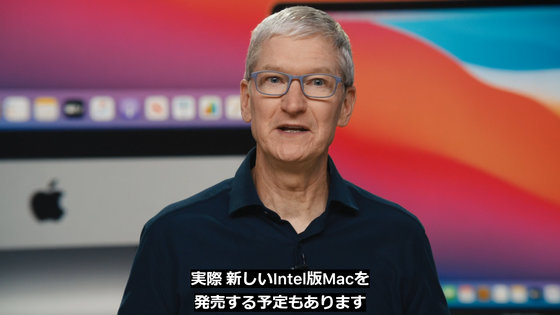Apple announces 'Apple Silicon' that migrates to proprietary processors on Mac, and iPhone & iPad applications can also be used on Mac
At WWDC 2020 , just as Apple uses proprietary processors for iPhones and iPads, the plan to adopt proprietary processors for the next-generation Mac, `` Apple Silicon '' was announced. CEO Tim Cook says, 'It will be a historic day,' and the next-generation Mac that uses proprietary silicon will be able to run iPhone and iPad apps with almost no modifications.
Apple announces Mac transition to Apple silicon - Apple
https://www.apple.com/newsroom/2020/06/apple-announces-mac-transition-to-apple-silicon/
WWDC Special Event Keynote — June 22, 2020 – Apple – YouTube
The Mac has continued to change to remain on the cutting edge of personal computers.
And the new change in the Mac is the installation of 'Apple Silicon'.
At Apple, the integration of hardware and software has become the basis, but Macs will finally have their own processors.
Apple has been developing its own silicon for over a decade. With a scalable architecture designed for Apple products, it boasts the industry's best features and performance per watt. He explains how the achievements so far will bring to the Mac of the future.
Apple's proprietary silicon started with the iPhone. For the iPhone, which required performance and capability that seemed impossible for its small size, Apple developed its own silicon with a focus on increasing performance-per-watt. Generation after generation, Apple's proprietary silicon, the A-Chip, has pushed the boundaries of technology, developing industry-leading features while improving performance and thermal efficiency.
The A-chip has improved its performance in 10 generations of complex designs.
And the CPU performance of the iPhone has actually grown to 100 times. It is ahead of any other device in the industry.
Apple is also developing its own processor for the iPad. Chips for iPhone could drive most iPads, but it seems that it was necessary to develop a dedicated custom chip to support Retina display. So we set out to design an optimal, high-performance chip for the iPad.
And the SoC line for iPad including A5X was born. We've increased the GPU and memory subsystem to deliver twice the graphics of the iPhone, making the graphics of the iPad unmatched.
Compared to the original iPad, the latest iPad Pro has 1000 times better graphics performance in just 10 years. This is why the iPad Pro runs faster than most laptops.
These are the very reasons why Apple develops its own processors for the Mac.
In addition, Apple has succeeded in developing a dedicated low-power chip for Apple Watch by optimizing the SoC architecture to the device requirements. Apple's SoC provides the functions and performance of individual products, and we take pride in tailoring each to the best in the industry.
Combined, these three products mean that Apple has shipped more than 2 billion processors in 10 years.
Bringing all this know-how to your Mac will dramatically improve your Mac's performance.
Power is an important factor when talking about performance. All current systems are constrained by power consumption and heat. Desktops are high performance but power hungry. On the other hand, notebook PCs have the disadvantage of lower performance due to the trade-off with low power consumption. High performance requires power, and Apple's proprietary processors are expected to deliver high performance at low power.
Leverages Apple's experience in developing the world's most energy-efficient chips to give your Mac a higher level of performance with less power consumption. For that reason, the Mac will move to a proprietary SoC.
Integrate Apple's proprietary technology and software to bring innovation to the Mac. Proprietary power management improves performance and battery life, while Secure Enclave provides advanced security. A high-performance GPU realizes high graphics performance.
We aim to provide these functions to all Macs and to optimize professional applications and games. Additionally, the Neural Engine turns the Mac into a platform for machine learning. By applying other proprietary technologies such as video, display, and image processing, Mac performance is advanced to an unprecedented level.
To that end, we will first develop an SoC for the Mac. Second, it brings the same great tech to the Mac as it did to the iPhone, iPad, and Apple Watch. To provide unique functions and high performance, and to have a common architecture for all products. It will make it easier for developers to develop software on the Apple ecosystem. Ultimately, it is possible to make Mac a better product with a uniquely designed SoC.
Apple's strength lies in the integration of silicon and software, and the purpose of Apple Silicon is to bring that to the Mac.
The next macOS 'Big Sur' natively supports Apple Silicon.
High-performance apps such as Final Cut Pro and Logic Pro also run as native applications.
Additionally, the new version of Xcode has all the tools needed to optimize for Apple Silicon.
Open a project and optimize your application within days.
Also, Universal 2, a binary for compatibility between Intel-based Macs and Apple Silicon-based Macs, is being developed.
There are also third parties such as Microsoft and Adobe that are already optimizing for Apple Silicon.
The Mac mini used in the macOS Big Sur demonstration was equipped with the ARM architecture SoC Apple A12Z Bionic installed in the iPad Pro.
Word actually running as a native application on Apple A12Z Bionic.
Apple is also working closely with Adobe...
Creative Cloud is already optimized for Macs with Apple Silicon.
Photoshop also runs natively on the Apple A12Z Bionic.
Plus, run Final Cut Pro on Apple Silicon.
Everything works very smoothly even on Apple A12Z Bionic.
By adopting Apple Silicon in the Mac. The same code can be used on Mac, iPad, and iPhone.
In addition, macOS Big Sur is equipped with Rosetta 2. This automatically makes your existing applications work on Apple Silicon-powered Macs.
It also supports JIT compilers and Java code browsers. It is said that the user can use it without being conscious and the performance is outstanding.
In addition, new virtualization technologies have been introduced.
This makes macOS Big Sur a system that can run various environments and various applications.
How to actually run iPad and iPhone apps directly on Mac
If you participate in the Quick Start Program, you will receive a Mac mini with A12Z Bionic, RAM 16GB, 512GB SSD storage, macOS Big Sur developer beta, and XCode for developers.
Also, the first Mac with Apple Silicon will be shipped at the end of 2020.
According to Cook CEO, the full transition to Apple Silicon is expected to take two years.

In addition, support for Macs with Intel processors and OS updates will continue, and there are plans to release new Intel version Macs in the future.

Developer beta versions for each OS will be released on June 23, 2020. In addition, the public beta version including watchOS will be distributed in July 2020. Other software will be released in the fall of 2020.
Related Posts:
in Hardware, Posted by logu_ii





